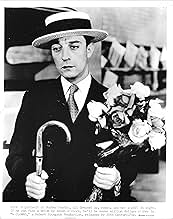WHILE NOT AS broadly based as were his earlier compilations, Robert Youngson's 4 CLOWNS (Robert Youngson Productions/20th Century-Fox, 1970) is nonetheless at least as satisfying and informative.
THE FILM COMES to us from a man whose producing such documentary fare was both his vocation and avocation. Beginning with 1957's THE GOLDEN AGE OF COMEDY and culminating with this, his last production, he's given us a reverent, nostalgic and very emotional overview of what made us laugh at the Movies. before they, themselves, made so much as a peep.
WITH THIS INSTALLMENT of the Silent Comedy story, we are focused on the work of four of the top laugh-makers of the era. The early careers of Stan Laurel, Oliver Hardy, Charley and Buster Keaton are highlighted. Although all men were active in the Sound Era, with varying degrees of success, their film roots were in the Silents and many feel that their best work was done there.
IN THE CASE of Mr. Laurel and Mr. Hardy, although their work as a team is included with THE SECOND HUNDRED YEARS (Hal Roach/MGM, 1927). The emphasis here is in their individual work and formative years. We see a brash, younger Laurel; whose persona bears a sort of resemblance to Harold Lloyd's go-getter Glasses character. Hardy's roles, both solo and teamed with others, are highlighted. In both men's cases, the style was much more frantic and not the slow, deliberate style that became synonymous with the L & H team.
SPECIAL ATTENTION IS given to Charley Chase; whose body of work tends to be overlooked and sometimes altogether forgotten. We particularly recall his LIMOUSINE LOVE (Hal Roach/MGM, 1928), a two reel comedy. This not only represents Mr. Chase's comic talents and style at their very zenith of their powers; but also one of the most unique, memorable and truly funny comedies ever.
THE LAST WAS saved for the very best as the anthology shifts the spotlight to "the Great Stone Face" of Buster Keaton is presented, front and center. We are privy to his early work and how he entered the motion business almost by accident; following a life-long career on the Vaudeville stage. From the age of three, he was a member of the 3 Keatons; along with Mom and Dad.
IN ADDITION TO the emphasis on the main subjects in the title's reference, of necessity, it touches on many others. For example, it shows us early, silent screen work of miss Jean Arthur; later to become a leading lady in the 1930's and a favourite of Director Frank Capra's.
THIS WAS ALSO the first reference that we had ever seen of one Billy West; who's stage impersonation of Charlie Chaplin brought him to the silver screen. As it is said in the narration, when moving it's impossible to tell Billy from Charlie.
WE'RE SURE THAT Mr. Youngson had as much joy in assembling this film as we had screening it. Thanks, Bob!


















